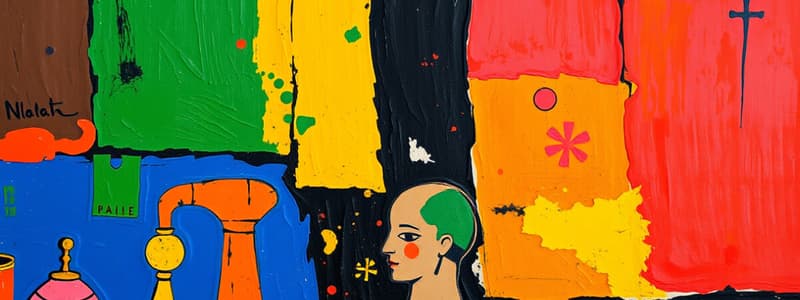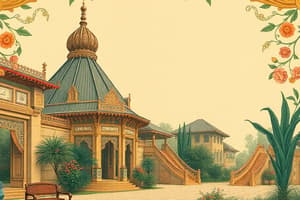Podcast
Questions and Answers
What do the small figures on the sculpted lid of the ancient pottery symbolize?
What do the small figures on the sculpted lid of the ancient pottery symbolize?
- Cultural unity and harmony
- Wealth and prosperity
- The concept of creation
- The rowing of souls to the afterlife (correct)
What does the term 'Linglingo' relate to in the context of its meaning?
What does the term 'Linglingo' relate to in the context of its meaning?
- A form of writing or literature
- A traditional dish from the Philippines
- The act of creation and manifestation (correct)
- A physical representation in art
Which ancient writing system is characterized by its use to write poetry and letters in the Philippines?
Which ancient writing system is characterized by its use to write poetry and letters in the Philippines?
- Baybayin (correct)
- Cyrillic script
- Latin script
- Arabic script
Which groups predominantly used the Baybayin script?
Which groups predominantly used the Baybayin script?
What is the primary characteristic of Islamic art as described?
What is the primary characteristic of Islamic art as described?
What design motif is significant in Islamic art, particularly among the Maranao and Tausug people?
What design motif is significant in Islamic art, particularly among the Maranao and Tausug people?
Which group is NOT mentioned as practicing Islam in the Philippines?
Which group is NOT mentioned as practicing Islam in the Philippines?
Which material is NOT historically listed as a component of Lingling O?
Which material is NOT historically listed as a component of Lingling O?
What is the primary feature of most ivory sculptures created by Chinese artisans for Spanish friars?
What is the primary feature of most ivory sculptures created by Chinese artisans for Spanish friars?
What significant element adorns the example of the Immaculate Conception mentioned in the content?
What significant element adorns the example of the Immaculate Conception mentioned in the content?
What art style combines letters and images of everyday life and became popular due to an 1884 order?
What art style combines letters and images of everyday life and became popular due to an 1884 order?
Who is known as the Father of Philippine Painting?
Who is known as the Father of Philippine Painting?
What type of painting was Damian Domingo primarily involved with?
What type of painting was Damian Domingo primarily involved with?
In what year was the Academia de Dibujo y Pintura established?
In what year was the Academia de Dibujo y Pintura established?
What famous artwork did Juan Luna create that won a gold medal in 1884?
What famous artwork did Juan Luna create that won a gold medal in 1884?
What does the term 'Spoliarium' refer to in relation to Juan Luna's painting?
What does the term 'Spoliarium' refer to in relation to Juan Luna's painting?
What was the primary artistic expression of early Philippine natives before the term 'art' was widely used?
What was the primary artistic expression of early Philippine natives before the term 'art' was widely used?
Which of the following is considered the oldest known artwork in the Philippines?
Which of the following is considered the oldest known artwork in the Philippines?
What is the significance of the Manunggul Jar in Philippine pre-colonial culture?
What is the significance of the Manunggul Jar in Philippine pre-colonial culture?
Who discovered the Angono Petroglyphs in 1965?
Who discovered the Angono Petroglyphs in 1965?
What year was the Angono Petroglyphs declared a National Cultural Treasure?
What year was the Angono Petroglyphs declared a National Cultural Treasure?
Which artistic forms were present in early Philippine culture?
Which artistic forms were present in early Philippine culture?
What period do the Angono Petroglyphs belong to based on archaeological evidence?
What period do the Angono Petroglyphs belong to based on archaeological evidence?
The distinct characteristics of Philippine art as per the historical lesson are influenced by which cultures?
The distinct characteristics of Philippine art as per the historical lesson are influenced by which cultures?
What was the primary influence on art until the mid-nineteenth century?
What was the primary influence on art until the mid-nineteenth century?
Which artist is most associated with the Amorsolo School of Painting?
Which artist is most associated with the Amorsolo School of Painting?
What technique did Amorsolo use in his rice-planting scenes to enhance the romantic undertones?
What technique did Amorsolo use in his rice-planting scenes to enhance the romantic undertones?
What type of sculpture did Guillermo Tolentino advocate for?
What type of sculpture did Guillermo Tolentino advocate for?
Which style characterized the products of the Academia de Dibujo y Pintura?
Which style characterized the products of the Academia de Dibujo y Pintura?
What term describes the elite portraits that became fashionable in the nineteenth century?
What term describes the elite portraits that became fashionable in the nineteenth century?
Which movement was modernism opposed to in the early twentieth century?
Which movement was modernism opposed to in the early twentieth century?
How did modernism resonate with the social changes in Europe?
How did modernism resonate with the social changes in Europe?
What characterized the pace of development in the Philippines during its colonial period?
What characterized the pace of development in the Philippines during its colonial period?
How did modernism in Philippine art differ from that in Europe during the Industrial Revolution?
How did modernism in Philippine art differ from that in Europe during the Industrial Revolution?
What was a primary feature of Philippine art during the Japanese Occupation?
What was a primary feature of Philippine art during the Japanese Occupation?
What theme dominated the propaganda during the Japanese occupation of the Philippines?
What theme dominated the propaganda during the Japanese occupation of the Philippines?
What significant contribution did Lydia Villanueva-Arguilla make to the Philippine art scene?
What significant contribution did Lydia Villanueva-Arguilla make to the Philippine art scene?
What did the poster 'The Fighting Filipinos' commemorate?
What did the poster 'The Fighting Filipinos' commemorate?
Which statement accurately reflects the influence of modernism on Filipino artists?
Which statement accurately reflects the influence of modernism on Filipino artists?
What was the overarching theme of art produced in the Postwar Republic period in the Philippines?
What was the overarching theme of art produced in the Postwar Republic period in the Philippines?
Flashcards are hidden until you start studying
Study Notes
History of Philippine Art
- Development of Philippine art spans from pre-colonial roots to contemporary styles influenced by various cultures, including Chinese, Indian, Islamic, Spanish, American, and Japanese.
- Significant struggles faced by modern artists in creating innovative and experimental art forms.
Pre-colonial Art
- Early Philippine natives integrated artistic expression into everyday life through rituals and ceremonies related to agriculture, hunting, and community practices.
- Indigenous art forms include pottery, weaving, carving, metalwork, and jewelry, which carry cultural meanings and decorative elements.
- Angono Petroglyphs: Comprises 127 figural carvings, dated to 3000 BC; discovered by Carlos “Botong” Francisco in 1965, recognized as a National Cultural Treasure.
- Manunggul Jar: A burial jar from 2700 years ago, noted for its sculpted lid representing souls journeying to the afterlife.
- Lingling O: An ancient fertility symbol worn by various Cordillera groups, made from materials like gold and jade, featuring a distinct circular shape.
- Baybayin: Ancient Philippine script used for poetry, letters, and documentation; significant literacy observed among natives before Spanish colonization.
Islamic Art (13th Century to Present)
- Islam established in Mindanao pre-Spanish colonial period with communities practicing their artistic traditions.
- Characterized by non-figurative designs, intricate patterns (Okir), and the use of art to express beauty and spiritual concepts.
- Artists, especially Chinese artisans, created ivory sculptures of religious icons, often depicting Asian features.
Spanish Colonial Period Artists
- Damian Domingo: Known as the Father of Philippine Painting; founded the first art academy in 1821, specializing in secular themes and miniature portraits.
- Juan Luna: Renowned for his painting "Spoliarium," which won a gold medal in 1884, remains a prominent figure of 19th-century Philippine art.
The Amorsolo School
- Emerged in the 1920s, defined by Fernando Amorsolo's romanticized rural imagery, particularly rice-planting scenes.
- Critiqued for their orientalist narratives while contributing significantly to the art market in a colonial context.
- Classical sculpture exemplified by Guillermo Tolentino, known for public monuments and classical themes.
Context of Modernism
- In Europe, modernism mirroring the Industrial Revolution differed from the slower pace of development in the Philippines, still influenced by feudalism.
- Filipino artists used modernism as a means to transcend academic repetition, blending local sensibility with romantic and traditional respect.
Japanese Occupation (1941-1945)
- Art during this period was heavily censored, focusing on traditional Asian aesthetics and Filipino struggles under occupation.
- Japan promoted Pan-Asian identity through propaganda, with artworks reflecting nationalistic themes, such as Fernando Amorsolo's "Bombing of Intendencia."
Postwar Republic (1946-1969)
- Post-war art depicted the reestablishment of national identity, addressing themes of recovery and resilience.
- Formation of the Philippine Art Gallery in 1951 by Lydia Villanueva-Arguilla marked a pivotal moment in promoting Filipino modern art and showcasing local talents.
Studying That Suits You
Use AI to generate personalized quizzes and flashcards to suit your learning preferences.




